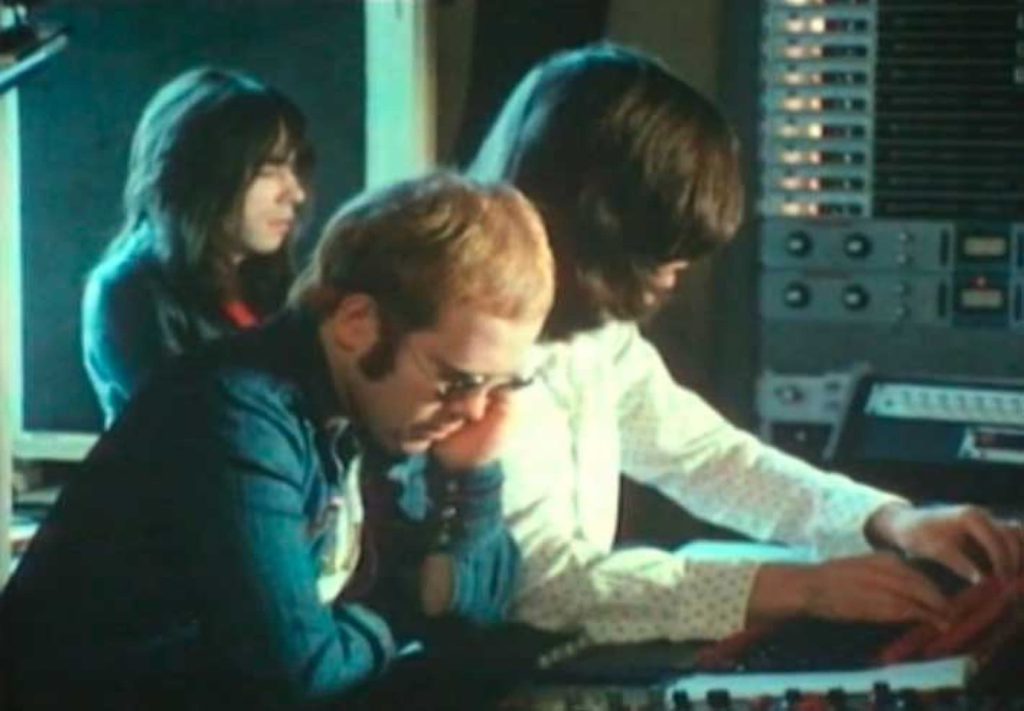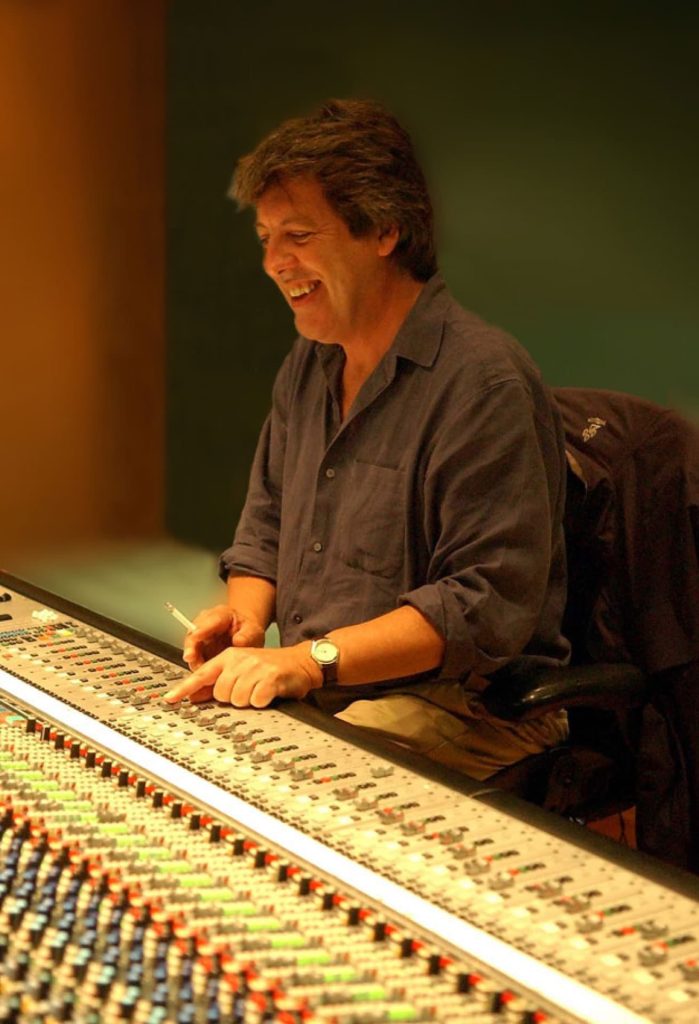Menu
Engineer David Hentschel Talks About ‘Goodbye Yellow Brick Road’

In May of 1973, engineer David Hentschel went to the Château d’Hérouville in France to work on the Elton John sessions that would eventually become “Goodbye Yellow Brick Road”.
In honor of the 40th Anniversary release of that landmark album, EltonJohn.com spoke with David about his role as an engineer as well as other aspects of the project. Here is part one of that conversation.
By John F. Higgins
What is the role of an engineer?
You could equate the recording engineer’s job to that of the director of photography on a film. Gus [Dudgeon, producer on Goodbye Yellow Brick Road] was running the whole session, much as a film director would, and I was basically in charge of setting up the instruments in the studio – putting them in the right areas. Choosing which microphones to use and placing them in the studio, plugging them into the console, getting the sounds…
★ To close the year, Elton was featured in 2018’s John Lewis Christmas advertisement. Called The Boy & The Piano, the two-and-a-half-minute video takes viewers through his remarkable career and back to his youthful love of his first piano, with Your Song as accompaniment. It was named the year’s most talked about Christmas commercial and landed at the top of the YouTube Christmas adverts list with over 12 million views.
How was the studio set up?
We had a window from the control room into the studio so we could watch the musicians, and beyond that was a view of the French countryside. The band recorded all in the same room; there were no isolation booths or anything. We had screens that you could move around that were acoustically treated – just to put on the side of the guitar amplifiers or something so they wouldn’t bleed [on to another instrument’s microphone]. The drums were in the same room.
For the piano, Gus came up with this contraption – a big wooden box that was custom-built to the shape of the piano and stood about 2.5 feet tall on top of the piano, in place of the piano lid. The idea was to keep the sound from the drums from spilling on to the piano mics
Were you given any direction for what to write for the intro?
The concept was to have it as a kind of overture, but it was down to me to juggle with some of the tunes from the songs [on the album]. It was almost a mathematical exercise as much as anything. Find things that would run together easily melodically, basically, and then make a melody that flows within itself. I know I used some lines from Danny Bailey, I’ve Seen That Movie Too, Candle In The Wind, and one or two others.
The way I used to work was to write charts out and then play monophonic parts on the ARP so I could play with one hand and adjust the gain and so on at the same time, to give it more dynamics. Playing polyphonically on analogue synths can give rather flat results. You don’t get any sense of movement. But if you write the parts out and then play them monophonically, then you get a lot more control.
The ARP 2500 had a split keyboard. The lower octave was capable of playing one note and the upper part was capable of playing two at the same time. But it was a nightmare to keep in tune, because it was all analogue circuitry. And there were just rotary pots, and the pots would get dirty and become intermittent. So it was a very imprecise science. Doing it one voice at a time was always the easier way to manage it.
The intro was on a separate piece of 16-track tape and we stitched it together [with Elton and the band’s recording] in the mixing stage. Because I had written out the arrangement first I could pretty much say, “Right, we’ll do maybe six or seven ‘string’ parts, and then we’ll mix those down to a stereo pair.” And we’d build it up that way on the multitrack.
I think I had three or four days to do it and write it down, and then when I got to the studio we did it all in about seven or eight hours.
Would you sometimes combine takes, using part of one take and part of another and editing them together to make one master?
With Elton and the band (and Gus), it was as much of a performance as possible. Not manufactured, which I have seen happen with other producers and musicians. Obviously, if you got two-thirds of the way through the song and it was sounding great and someone made a howler, then you would do the last section and chop it on. But it certainly was not approached with, “Let’s just get a good verse and then let’s get a good chorus and we can stitch them together later.” Quite a few recordings would have been one take. I’m not saying the first take… it may have been the fourth or fifth take… but one pass straight through.
The basics were all done together: drums, bass, piano, and main guitar. Any double-tracked or overdubbed guitar would have been done straight after. And Elton sang guide vocal on most of them, and then the final vocals were done afterwards – on the same day or soon after.
After that was done I would have been left with maybe five or six tracks to record on. And those would have been used to record the backing vocals. Davey, Dee and Nigel sang together, but it was always more than one pass. So we’d do maybe two passes of them singing the same notes. Then we’d get them to change parts and/or positions on the mic. So you would build up the backing vocals. ‘Cos you only had six tracks to work with, if we’d filled them up with all the backing vocals there’d be no tracks left for anything else. So as we went we would “bounce down”: we would take the first double-track and bounce that down to mono. And then the same with the second. Then we would put them together and probably end up with two tracks, in most cases, of backing vocals. That would free up the last three or four tracks for things like tambourine, the orchestra and the ARP synthesizer. Those would have been the very last things to be recorded.
On May 28th, Elton and Ray gave their second concert at Rossiya Hall in Moscow, part of a massive hotel complex consisting of 6,000 guest rooms. The show was aired, not without some technical difficulties in the set-up, in stereo on BBC Radio. Both countries were keen to test out the broadcast lines as they readied for the 1980 Moscow Summer Olympics. Fans in the UK were able to enjoy the goings on starting at 5:30 pm Monday night from the comfort of their own homes, listening to Radio 1 announcer Andy Peebles introduce the festivities by commenting on how the venue reminded him, somewhat surprisingly, of London’s Royal Festival Hall.
The Moscow concerts went from strength to strength and as Elton prepared to leave Moscow for London, he spoke with some fans about their musical tastes and made a present of a video cassette of one of his favourite bands at the time, the Sex Pistols. He continued to receive gifts as he moved about in public, appreciating that even the smallest of them set their giver back a good amount due to the local economy. With every passing day, Elton’s appreciation of the young people who came up to him on the street grew and he left the country with a Russian spring in his step.
And they were recorded after Elton had done his parts?
Yes, he’s off shopping for trousers and “sparklers” (jewellery), as he used to call them, in Paris or something. So it would be Davey, Dee, Nigel, Gus and myself. We’d all sit or stand around the console and put the song on and listen. And we’d try notes and parts out. There were ideas going all around between us (but Gus and I did not sing on the track). In a few cases, because I had some musical training, I would throw in a couple of harmony ideas or whatever. “Why don’t you drop down there…or double it.” That sort of stuff. So it would all be figured out before they even went into the studio. And then they just went in and did it… very quickly. The blend was extraordinary. There were usually at least two passes, or maybe four on the ones we felt we wanted “thicker” backing vocals on.
How did you get Bennie And The Jets to sound “live”?
That was one of the first uses of the Digital Delay Line, which was a digital method of producing (very short) delays. That was the main effect we used, on the hand claps. There were only three of us doing the hand claps, and we wanted to make it sound like a huge stadium audience clapping along to the song! So it was the three of us purposely trying to clap outside the time. We did it over and over again and for each pass that we did I could make it sound like nine people instead of the three, so it ended up sounding like about 40 people…and then with juggling reverbs and furthering the delays I made it sound like the real thing. And we also used recordings of Jimi Hendrix Live From the Isle of Wight – audience effects of the crowds cheering and that kind of stuff.
Did you know, when you were working on Goodbye Yellow Brick Road, that you were involved in something above the norm?
It’s funny, but when you’re involved in a record sometimes you get a sense that it is something very special. And we had that sense when we were at the Château. The more it went on the more you felt it. You’d go, “Wait a minute, I think we’ve got something pretty damn good here.” You don’t want to be smug about it, but that feeling sort of grows with you. It’s a sort of confidence as you go further and further through it. Everything starts to gel and things fall into place. Because it was a relatively easy album to make, in terms of the whole process. And it was fast. After we were in the Château we just spent maybe another week overdubbing [at Trident Studios in London] and then two weeks mixing, probably. For a double album, that is very fast.
Everyone was so focused. That is one thing that working in a residential studio gives you, if you can manage to be in the same room the entire time with the same people. It’s like someone coming to stay at your house! But it does give you that wonderful focus, and I think that’s why it happened so easily.

Do you have a special memory of the experience at the Château?
What I remember most of all was the warmth. As Elton has said, we were like a little family there. Because we were all living there, and wives and girlfriends came over and all that kind of stuff. That spirit was just so wonderful. There was no squabbling or arguments. I know it sounds unlikely, but it’s true.
